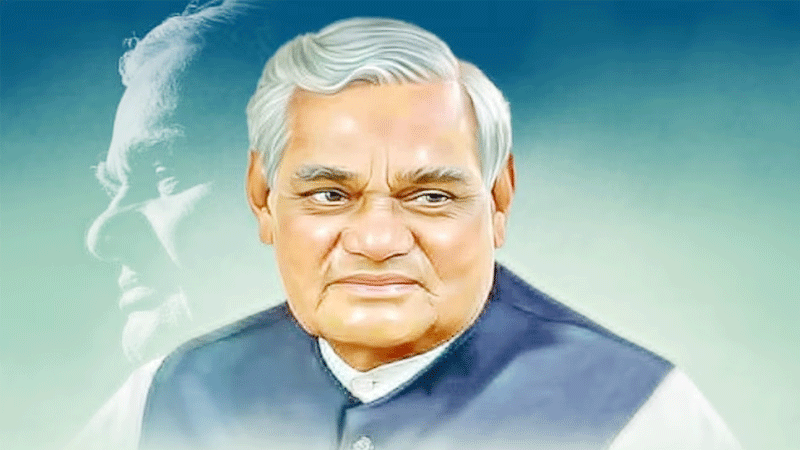Special on 44th BJP Foundation day
– Atal Bihari Vajpayee
Administrative Paralysis
In New Delhi today, there is a Government, but there is no administration. There is a Prime Minister, but one who has lost her grip. The secretariat is there as always, but the services seem struck by paralysis as it were. No decisions are being taken. No one is willing to own responsibility. Ministers wear a permanant look of nervousness, always fearful of the hour when they too might be shown the boot like Kamalapati Tripathi. The bureaucracy is demoralised, and feels apprehensive lest, for being upright in the performance of their duties, they should have to suffer humiliation or even imprisonment as DIG, CBI Shri N.K. Singh had to suffer.
Loyalists Rewarded
The rewarding of Ministers and officers who had debased and discredited themselves during the emergency has had a very unhealthy effect on the entire administration. Victory in elections, which naturally depends on many factors and circumstances, cannot wash away the categorically proved conclusions of the Shah Commission, nor convert the stinking scandal of Maruti into a monument of good conduct.
Defections Encouraged
During the last 12 months, the immoral process of defections promoted by selfishness and lust for power has continued unabated. Instead of trying to halt this, the ruling party has been unabashedly engaged in trying to seduce and corrupt potential floor-crossers. As a result, the already soiled reputation of politicians has been further tranished. More distressing still, the party system itself has been seriously undermined.
When the Assam Assembly was placed under ‘suspended animation’, the Cong (I) had only 8 legislators. Now the party has 56. It may be noted that this accretion of strength has taken place during a period when the youth of Assam were immersed in a life and death struggle to save their State from foreign infltration. Their struggle continues even today but the Centre is unable to provide any solution.
Police Atrocities
A large section of the people in Moradabad feel convinced that they can receive no protection from PAC. The Bhagalpur police also seems to believe that by blinding undertrial prisoners, they have only effectively discharged their duty of curbing crime. The stripping of a woman in Baghpat by the police and parading her naked in the streets was shameful, but even more disturbing is the fact that hundreds of people watched this outrage in mute helplessness. All these happenings are pointers not merely of administrative failure or of a decline in social consciousness; they indicate a virtual distinegration of our institutional framework. Some political analysts have described the situation as “a civilisational crisis”.
Whatever be the epithet used to describe this crisis, there is no doubt that this crisis is unprecedented. The fading charisma of one individual, the influence of a party cracking up with dissensions and the battered prestige of government are certainly in no position to surmount this crisis.
Sinister moves to install a “President for Life”
People who advocate adoption of the presidential system in place of our present parliamentary democracy as a panacea for these ills are either fools or knaves. In most cases, it is the latter description which would fit.
Talks about a “President for life” and an “elected judiciary” are not the fancies of an individual. They are indices of a deep conspiracy which aims at perpetuating the hold on the State acquired by the present rulers with the help of negative votes. If these designs succeed, India would cease to be a republic. This conspiracy must be exposed and frustrated before it can materialise.
Electoral Reform
An analysis of the 1980 election results would show that once again a party that failed to secure the support of the majority of electors has succeeded in capturing power. In the last Lok Sabha elections, the Cong. (I) secured 351 seats out of 525, but in terms of votes the Cong (I) got only 42.56% of the votes cast.
Indeed, it is one of the major quirks of our election system that under this system, on the basis of minority votes a party is able to secure an overwhelming majority of seats. Right since 1952, there has been not a single election in which the winning party has been able to secure the support of a majority of the electorate. Even the Janata Party, when it won the elections in 1977, got only 43.06% votes.
Election a Big Gamble
This system yields odd results. In 1977, the Janata Party secured 43.06% votes but on that basis got only 298 seats, whereas in 1971, with almost the same voting percentage, the Cong (I) was able to get 350 seats. Then again in 1980, with 42.56% votes, the Cong (I) managed to get 66.86% seats whereas in 1977, with a higher poll percentage of 43.06%, the Janata could get only 56.80% seats in Parliament. Critics of this system in Britain have said that this system makes elections a big gamble.
Majority with Minority of Votes:
It is evident that under this system, the people’s will is not fairly reflected in the legislatures. The ‘massive mandate’ bragged about by winning parties is generally illusory. These parties represent only a minority of the populace. Nonetheless, by virtue of their legislative majority, momentous decisions are taken in legislatures, laws are changed, the Constitution is radically overhauled, but the majority sanction behind these changes is really missing.
Need to Adopt a Different System
It is imperative that electoral reform is undertaken urgently. In place of the present majority system of elections that we have, we should adopt some variation of the List System, a system that has been worked successfully by most European democracies. The biggest advantage of the List System is that it would politicise the electorate, make them think in terms of party policies and programmes and thus minimise, if not eliminate, the vitiating influence of caste and community that presently dominates the thinking of the average voter. Above all, the List System will stabilise the party system which under the present system remains in a state of perpetual flux. It will not make elections the kind of gamble they presently are. Parties would be represented in Parliament and the State Legislatures broadly in proportion to their actual support in the people. No doubt, the Majority system has some advantages. One person representing one constituency can better attend to the developmental needs of that constituency. West Germany has tried to combine the plus points of both the Majority system and the List system and has evolved what is known as the Mixed System. It would be of advantage perhaps if we adopt the List System for Lok Sabha elections and the Mixed System for State elections.
A Joint Parliamentary Committee on Electoral Reforms constituted in 1973 had recommended that an experts body should be appointed to examine the feasibility of adopting the List system in India.It is a matter of regret that there has been no follow up on this recommendation yet. In this respect, the Janata Government also cannot be absolved of blame. The Janata Government did, however, approve of several other far reaching electoral reforms, such as public financing of elections, and had decided to discuss its proposals with Opposition Parties before initiating necessary legislation in that regard. I demand that the Experts Committee suggested by the Parliamentary Committee earlier should be set up without delay, and that the proposals drawn up during the Janata regime be implemented.
To be continued…
(Presidential address of Shri Atal Bihari Vajpeyee at BJP National Council, Bombay, 28-December, 1980)


